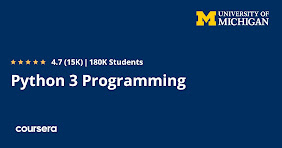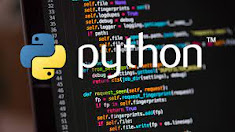Colleagues, join the 182,662 developers enrolled in the Python 3 Programming Specialization where you will learn to write programs that query Internet APIs for data and extract useful information from them. And you’ll be able to learn to use new modules and APIs on your own by reading the documentation. That will give you a great launch toward being an independent Python programmer. Training modules include: 1) Python Basics - conditional execution and iteration as control structures, and strings and lists as data structures. You'll program an on-screen Turtle to draw pretty pictures. You'll also learn to draw reference diagrams as a way to reason about program executions, which will help to build up your debugging skills, 2) Python Functions, Files, and Dictionaries - dictionary data structure and user-defined functions. You’ll learn about local and global variables, optional and keyword parameter-passing, named functions and lambda expressions. You’ll also learn about Python’s sorted function and how to control the order in which it sorts by passing in another function as an input. For your final project, you’ll read in simulated social media data from a file, compute sentiment scores, and write out .csv files, 3) Data Collection and Processing with Python - fetch and process data from services on the Internet. It covers Python list comprehensions and provides opportunities to practice extracting from and processing deeply nested data. You'll also learn how to use the Python requests module to interact with REST APIs and what to look for in documentation of those APIs. For the final project, you will construct a “tag recommender” for the flickr photo sharing site, 4) Python Classes and Inheritance - classes, instances, and inheritance. You will learn how to use classes to represent data in concise and natural ways. You'll also learn how to override built-in methods and how to create "inherited" classes that reuse functionality. You'll also learn about how to design classes. Finally, you will be introduced to the good programming habit of writing automated tests for their own code.
Enroll today (teams & execs welcome): https://tinyurl.com/28cruk7u
Download your free AI-ML-DL - Career Transformation Guide.
Much career success, Lawrence E. Wilson - Artificial Intelligence Academy (share with your team)

.jpeg)
.jpeg)

.jpeg)
.jpeg)



.jpeg)



.jpg)
.jpeg)

